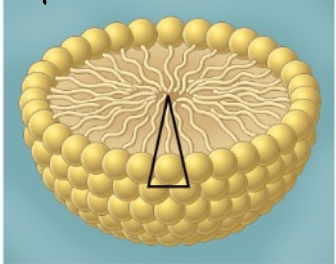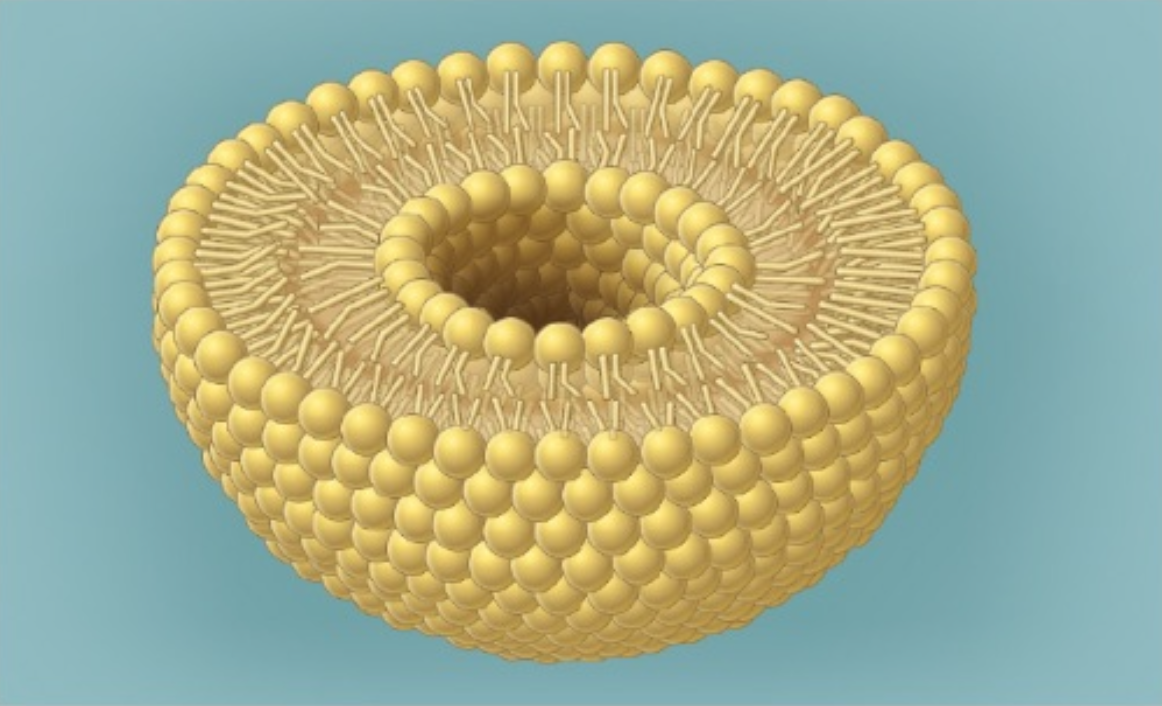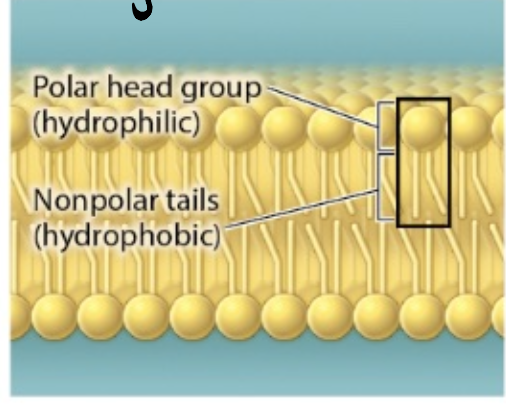class 10 - membranes and transport
1/61
There's no tags or description
Looks like no tags are added yet.
Name | Mastery | Learn | Test | Matching | Spaced |
|---|
No study sessions yet.
62 Terms
structure of cell membrane
made of mostly proteins and lipids
types of lipids: mostly phospholipids, with some steroids like cholesterol)
contains glycolipids + glycoproteins (carbohydrate- modified lipids and proteins)
"glyco” = carbohydrate is fluid nad amphipathic
amphipathic
"two-faced"- phospholipid bilayer has polar/charged head, nonpolar fatty acid tail
function of cell membrane
cell membrane separates aqueous (watery) environment from external aqueous environment, maintaining homeostasis
is selectively permeable
homeostasis
keeping the internal environment stable by actively regulating it while the external environment is is changing
what structures do phospholipids spontaneously form in water?
micelles, lipisolmes, and bilayer sheets
micelles
single-layer lipid sphere, wedge shaped, bulky head

liposome
rectangular shape with less bulky phosphate head, sphere made out of phospholipid bilayer

bilayer sheet
basic structural arrangement of cell membrane before curving into closed shape (forms liposome)
consists of polar head group facing the external environment, and nonpolar tail facing the internal environment
is selectively permeable

selectively permeable
some molecules can move in and out freely, while other molecules are let in and out under certain conditions, and other molecules can't pass through at all
small/nonpolar molecules: can diffuse freely through the membrane
polar/charged molecules: must go through facilitated diffusion
describe the structure of the phospholipid bilayer
flat sheet of phospholipids arranged tail-to-tail
phospholipid molecules are amphipathic, which allow them to orient the polar end towards the water inside and outside the cell, while nonpolar tail faces inwards
what is solidification?
at low temperatures, linear fatty acid tails are packed closely together, making phospholipids vulnerable to fracturing
how do you avoid solidification from occurring?
cholesterol spread among phospholipids, preventing crystallizing (cholesterol's bulky ring structure interrupts close packing)
cholesterol structure
amphipathic, hydrophilic head with hydroxyl group, hydrophobic nonpolar tail where carbon rings are located
kink in one of the two fatty acid tails occurs due to double bond, making an unsaturated C
phospholipid vs cholesterol
cholesterol has a hydroxyl head, phospholipids have a phosphate group head
fluid mosaic model
describes the cell membrane structure as fluid, as it is able to vibrate, flex back and forth, spin around long axis, sideways, etc
this happens constantly; there’s enough interaction between amphipathic phospholipids and surrounding aqueous solutions that it all stays together
how does the fluid mosaic model stay fluid?
balance of unsaturated and saturated fatty acid tails
unsaturated fatty acid tails → double bonds create kinks, preventing phospholipids from packing tightly and increasing fluidity
saturated fatty acid tails → straight tails, tighter packing, which decreases fluidity
what does membrane fluidity allow the cell membrane to do?
allows membranes to accommodate for cell growth, cell movement/motility, and surface stresses that cells or multi-cellviar organisms may come up against
how does the membrane stay fluid despite the temperature?
cholesterol - acts as a buffer
at high temps, cholesterol stiffens the membrane, preventing it from getting too fluid.
at low temps, cholesterol wedges between tails, preventing them from packing too tightly, preventing solidification
integral proteins
proteins that span the entire membrane, involved in transport, signaling, and maintaining cell structure
same as transmembrane proteins
transmembrane proteins
proteins that span the entire membrane, involved in transport, signaling, and maintaining cell structure
same as integral proteins
transporter protein
moves material into/out of cell
forms selectively permeable channels that allow certain polar molecules and ions to pass across the membrane
receptors
bind to chemical signals from other cells, organisms, the environment, and then transmit the signal they've received intracellularly- involved in all cellular signaling
enzymes
catalyze chemical reactions happening at the surface of the cell or inside of the cell
anchor proteins
help with stabilizing the cell+ attaching cell to surrounding extracellular matrix
cell-cell recognition proteins
identifies a cell as part of the same cell or a foreign, links cells, binds cells to extracellular matrix (ECM) to link ECM to cytoskeleton
ex: immune systems determine if something is foreign invader (ex: bacteria, virus)
proteins embedded in fluid mosaic of cell's membrane
must have hydrophobic + hydrophilic regions
proteins in cell-cell junctions
bind cells tightly together
enzymatic proteins
allow chemical reactions to occur
glycoproteins
carbohydrate-modified protein, contains a sugar group usually involved in immune recognition
concentration gradient
high to low
occurs when there’s a higher concentration on one side of the membrane compared to the other
what does “moving down the concentration gradient” mean
moving from high to low concentration areas
diffusion
net movement of molecules driven by the natural kinetic energy of molecules (random motion), not by cellular energy (ATP)
what happens when there is no more concentration gradient (the concentration on both sides is the same)?
net movement of particles stops, but random motion of molecules in both directions continues
electrochemical gradient
uneven distribution of charged molecules
what type of energy do gradients contain?
potential energy
hypertonic solution
a solution with a higher solute concentration than another solution
hypotonic solution
a solution with a lower solute concentration than another solution
isotonic solution
a solution with the same solute concentration as another solution
passive transport
moving down the gradient by diffusion
simple diffusion
small hydrophobic molecules diffuse directly through the membrane
net movement continues until concentration is the same on inside and outside of cell, at which point net movement stops but diffusion continues
facilitated diffusoin
diffusion across cell membrane through a transmembrane transport protein
(channels or carriers), moves polar and charged molecules
channel proteins
static core
stable tertiary structure
substance moves through channel that can go from closed to open state
typically moves amino acids, sugars, and ions
aquaporins
type of protein channel
allow water to cross faster than diffusing through the lipid bilayer
osmosis
net movement of a solvent (ex: water) across a selectively permeable membrane from low to high solute concentration (aka high to low water concentration)
osmotic pressure
tendency of water to move from one solution to another by osmosis
higher solute concentration = higher osmotic pressure
relationship between water and solute concentration
water is inversely related to solute concentration
high water concentration = low solute concentration
active transport
protein assistance moving against concentration gradient (low to high concentration), any substance is capable of active transport
where does the external energy come from to power active transport?
an energy carrying molecule (typically ATP)
the concentration gradient of another molecule or ion
primary active transport
ATP is used as a fuel source to pump from a low to high concentration
secondary active transport
instead of breaking down ATP, a protein partners the passive movement of substance one with the primary active transport of substance two
types of secondary active transport
symporter- moves two substances in the SAME direction across the membrane
antiporter- moves two substances in OPPOSITE directions across the membrane
what is the membrane component involved in simple diffusion, facilitated diffusion, and active transport?
simple diffusion: lipids
facilitated diffusion: proteins
active transport: proteins
does the transported substance have to bind to a carrier in simple diffusion, facilitated diffusion, and active transport?
simple diffusion: no
facilitated diffusion: yes
active transport: yes
what is the energy source in simple diffusion, facilitated diffusion, and active transport?
simple diffusion: concentration gradient
facilitated diffusion: concentration gradient
active transport: ATP hydrolysis or a different substance’s concentration gradient
what is the direction of transport in simple diffusion, facilitated diffusion, and active transport?
simple diffusion: with gradient (high → low)
facilitated diffusion: with gradient (high → low)
active transport: against gradient (low → high)
can the mechanism cause saturation by simple diffusion, facilitated diffusion, and active transport?
simple diffusion: no
facilitated diffusion: yes
active transport: yes
when does protein saturation occur?
occurs when all the binding sites on a protein are fully occupied by a substrate or ligand
what happens when you add substrate and the protein is at max saturation?
adding substrate or ligand won’t increase protein activity
what is the impact of steroids/sterols (ex: cholesterol)?
function: stabilizes membrane
low temps → prevents tight packing and solidification → increases fluidity
high temps → keeps membrane together → decreases fluidity and permeability
what is the impact of double bonds on the cell membrane?
double bond function - reduces saturation of fatty acid tails
more double bonds = more unsaturated = increased fluidity and permeability
what is the impact of unsaturated and saturated fatty acids on the cell membrane?
more saturated (fewer double bonds) → tighter packing → less fluid and permeable
less saturated (more double bonds) → creates kinks → looser packing → more fluid and permeable
what is the impact of protein content on the cell membrane?
more transport proteins → increases selective permeability (larger amount of specific molecules/ions cross)
more anchoring proteins → stabilize protein structure
more receptors/enzymes → no impact on fluidity/permeability